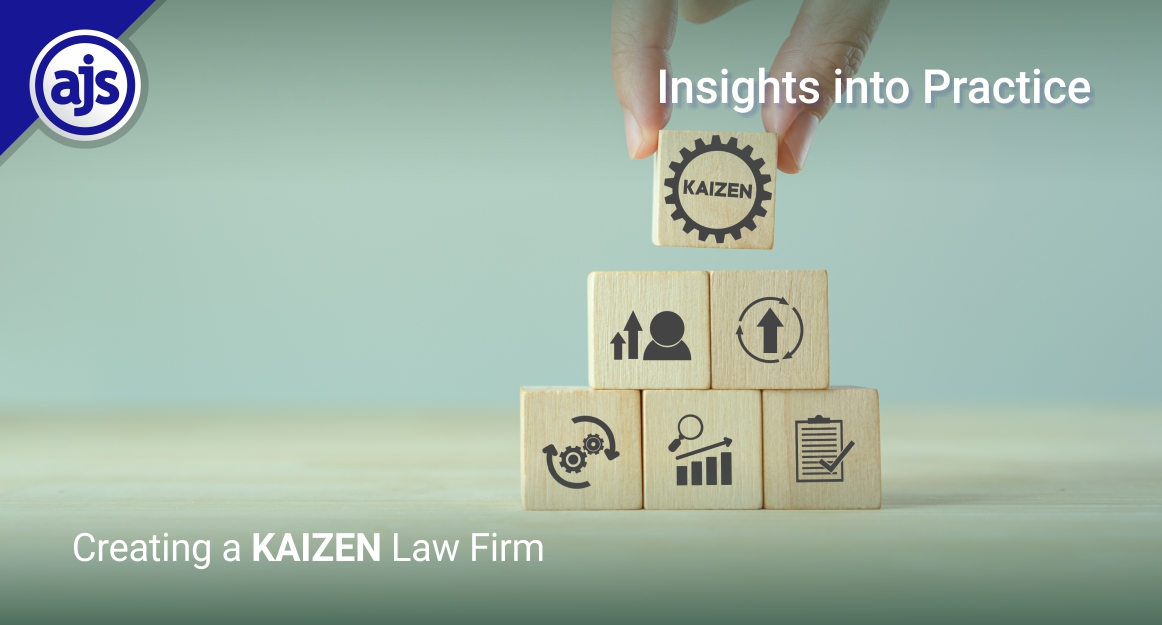
BUILDING A KAIZEN LAW FIRM
Insights Into Practice
Have you ever been curious as to what goes on in the minds of other legal practitioners? Have you ever wondered whether you measure up?
It’s only natural, after all it’s human nature to be curious about the world and the people around you – how do they do what they do?
With that in mind, join us as we investigate frequently discussed topics, with the aim of discovering innovative approaches to the practice of a law in an ever-changing and evolving world.
Take this blog’s topic – BUILDING A KAIZEN LAW FIRM – How do you even go about doing that?
What is Kaizen?
Kaizen is a word that kind of gets stuck in your throat. Something that feels philosophical and worthy of attention but foreign and unfamiliar.
It’s a word that describes a work ethic that has been employed by Toyota since the 1950’s.
Kaizen has its origins in World War II. When the United States entered the war, a group of Americans led by W. Edwards Deming, an engineer and statistician, he was considered by many to be the master of continual improvement of quality, as well as overall operation, Deming is best known for his pioneering work in Japan. Deming, beginning in 1950, set out to convert car factories into tank factories, quickly and with minimal resources. To achieve this, Deming and his colleagues asked the workers to find small ways to improve their processes and quickly found out that minor changes led to significant, measurable, and innovative results.
After World War II, Deming travelled to Japan to help with manufacturing, as Japan was trying to rebuild. The Japanese took to heart the Deming principles. Businessman and industrial engineer Taiichi Ohno, an engineer and former Toyota executive was the first Japanese business figure to translate Deming quality control principles into incredible, world-leading results. He called it the Toyota Production System (TPS). TPS, also known as “just-in-time” manufacturing, a system for reducing waste and maximizing efficiencies through continuous improvement.
“Kaizen, or continuous improvement, is the hallmark of the Toyota Production System. The primary objectives are to identify and eliminate “Muda,” or waste in all areas, including the production process. “Kaizen” also strives to ensure quality and safety. Its key elements emphasize making a task simpler and easier to perform, re-engineering processes to accommodate the physical demands on team members, increasing the speed and efficiency of the work process, maintaining a safe work environment, and constantly improving the product quality” (QualitiAmo).
Toyota goes on further to add that –
Kai’ means ‘change’ and ‘zen’ means ‘for the better
It’s important to distinguish between substantial changes with meaningful results and slight changes. Kaizen teaches that making minor changes will help to break bad habits and create a routine in daily activities.
Kaizen is the path of continuous improvement; no matter what it is, knowing that there is always room for improvement.
It’s a philosophy and management approach that can be applied to various aspects of life, including personal and professional development. Because it’s focused on small, established changes, they can be easily performed and measured (!) over time and on a regular basis.
The philosophy of Kaizen can be applied to many areas of business, including manufacturing, service industries, healthcare, and of course in the legal profession.
How to apply the Kaizen philosophy in your law firm
Kaizen is easy enough to understand, with minor changes are not too hard to implement, and because Kaizen is a broad concept – what with “change for good” – the philosophy can be applied in many different ways within your law firm.
The aim for lawyers is to continually deliver value whilst also improving on service delivery. And this can be done by –
1. Getting organisational buy-in – to ensure that the correct changes are implemented in order to sustain growth and continued improvement, it’s important to instil an understanding of Kaizen as a long-term practice, rather than a once off initiative. Everyone in the organization from senior partners to the cleaning staff should be involved in the process.
2. Utilisation of resources – Kaizen is all about repurposing existing resources to improve on product or service offering. And in this head space, the focus should be on incremental, daily changes in order to achieve long-term improvement.
3. Increased efficiency – integral to the practice of Kaizen is having a well-planned work area that eliminates unnecessary or unwanted waste and ensuring that employees are professionally trained in a way that’s efficient.
4. Employee Satisfaction – Kaizen is about creating an atmosphere of teamwork and change, where innovative ideas are encouraged. Team members are asked to examine the processes and make suggestions for improvement.
5. Identify issues and opportunities – in order to ensure that continuous, incremental, positive change is taking place, one needs to ensure that they identify issues and opportunities for improvement. This can be done by observing the workplace, gathering feedback from employees, and analysing data. Most importantly, this means accepting challenges to the status quo. Accepting and embracing the chaos that is change and being willing to rebel against the norm in order to effect the right change for your law firm.
6. Implement small, positive changes – Kaizen focuses on applying small, repetitive changes that result in vast improvements. Over time. These changes should involve all employees. The next step is to determine how you can best meet client needs in an efficient, friendly, systematic fashion.
7. Measure and evaluate results – After implementing changes, it’s crucial to measure and evaluate the results achieved due to the change. This helps to identify whether the changes have been effective and whether further improvements are required.
8. Create a culture of continuous improvement – Kaizen is not just a tool for improving the ins and outs of law firms. It’s a way of thinking and a culture that values continuous, incremental improvement. By creating a culture of continuous improvement, businesses can sustain improvements over the long term (Law.com; Karta Legal).
At the end of the day, the goal with Kaizen is to build a law firm that isn’t fragile, one that’s not hostage towards change. Instead, the aim is to build a law firm that does the opposite – one that’s constantly open to change, embracing disorder and chaos in a way that is orderly, that is principled and one that takes the changes in its stride.
The Kaizen approach enables law firms to not just survive but thrive amid changes and challenges by being rebellious to the norms, by being proactive and innovative in the way that they address change and ultimately prepare for the future.
AJS is always here to help you, wherever and whenever possible!
(Sources used and to whom we owe thanks: Deming; Automative Hall of Fame; QualitiAmo; Toyota; Karta Legal; Law.Com and LinkedIn).
– Written by Alicia Koch on behalf of AJS





Leave a Reply